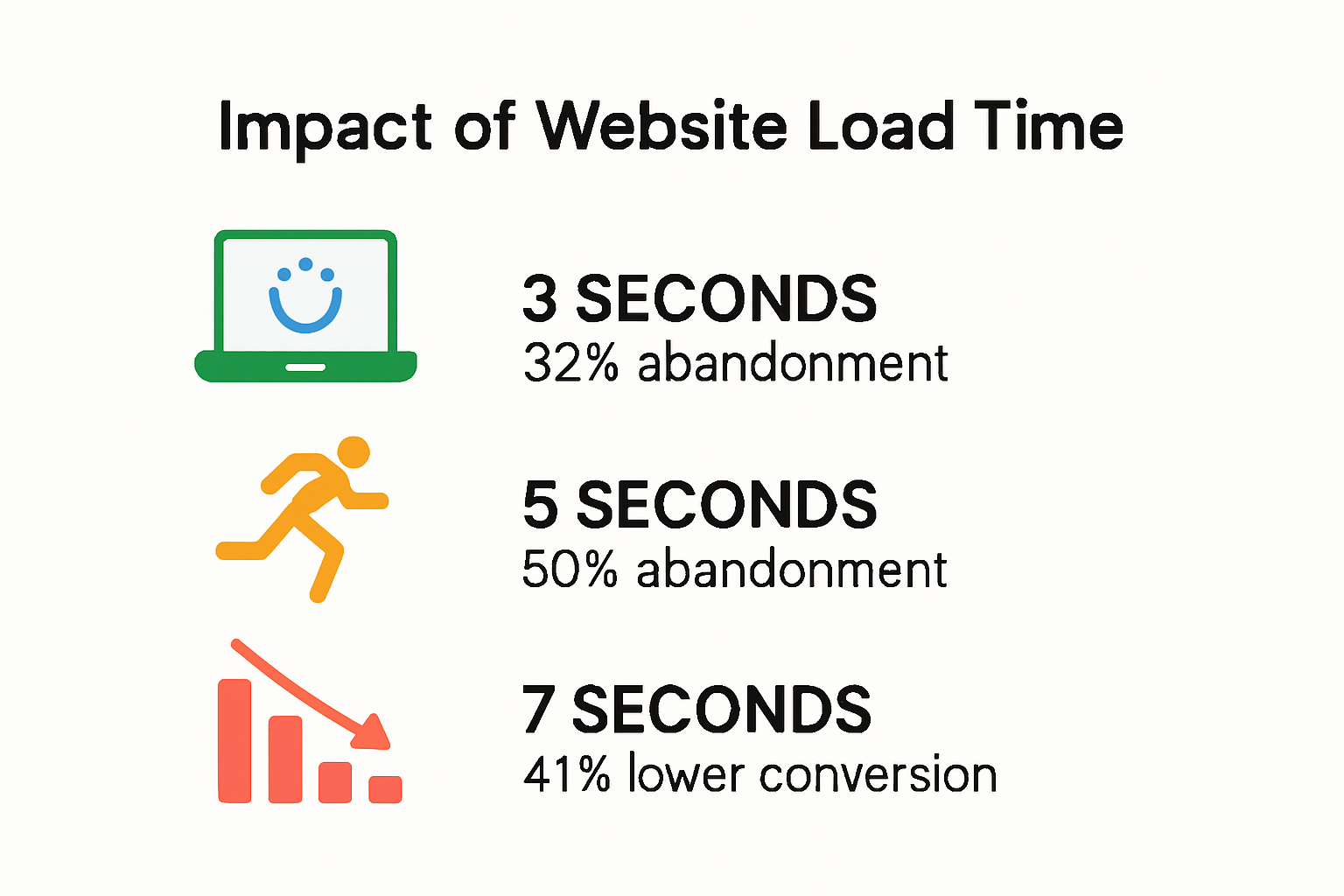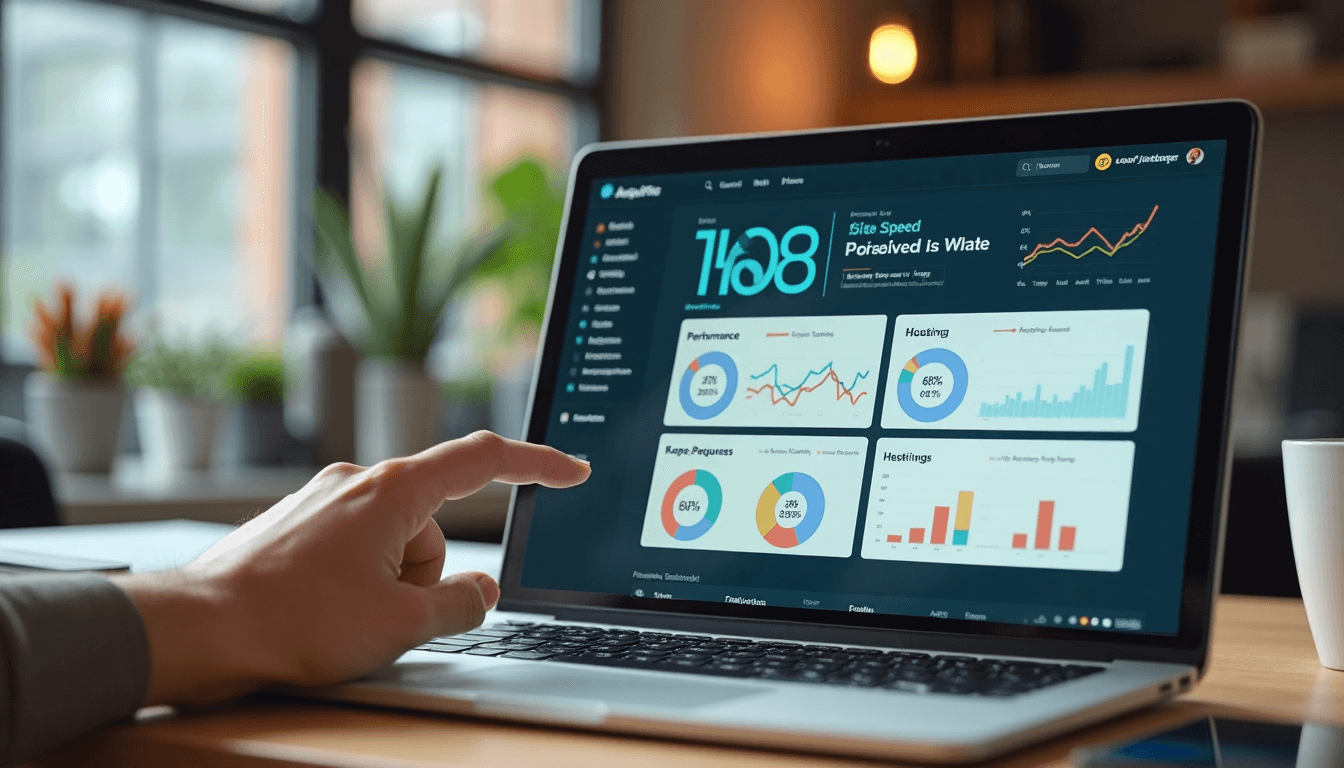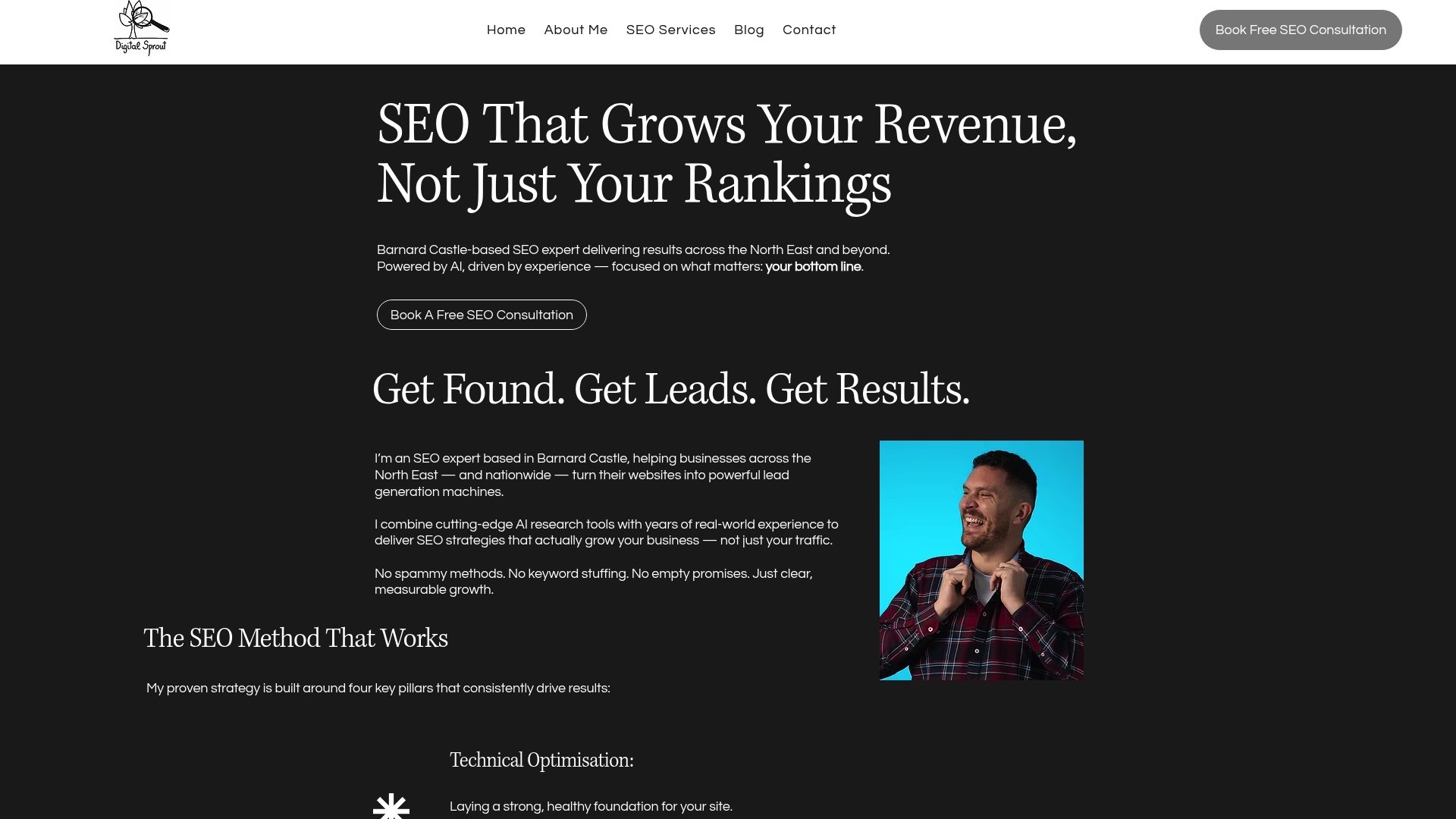Site Speed Optimisation Strategies for UK Businesses 2025
- Mike Dodgson

- Jul 8
- 7 min read
Website visitors are growing more impatient every year, and even the tiniest digital delays can drive them away. Here is something most business owners don’t expect. A single second of extra load time can slash conversion rates by 7 percent, and nearly 40 percent of users refuse to wait longer than 3 seconds. An eye-catching design or clever marketing message might not matter if your site keeps users waiting. The real secret to higher sales and loyal customers is probably hiding in your site speed.
Table of Contents
Quick Summary
Why Fast Site Speed Matters for Your Business
In the digital marketplace, your website’s performance is a critical determinant of business success. Site speed optimisation isn’t just a technical detail - it’s a fundamental driver of user experience, search engine rankings, and ultimately, your bottom line.
The Hidden Cost of Slow Websites
Every second counts when users interact with your online presence. Research indicates that a one-second delay in page load time can trigger a dramatic 7% reduction in conversions. This isn’t a minor inconvenience - it’s a substantial potential revenue loss that can cripple business growth.
Moreover, user patience is rapidly diminishing. Studies demonstrate that 40% of users will abandon a website that takes more than 3 seconds to load. This means nearly half of your potential customers might leave before even seeing what you offer, simply because your site loads too slowly.

To clearly visualise the key statistical impacts of slow site speed discussed in this section, here’s a concise summary table:
Economic Impact of Digital Performance
Beyond immediate user experience, site speed has broader economic implications. A comprehensive study analyzing data from England found a fascinating correlation: a 1% increase in broadband download speeds was associated with a 0.0574 percentage point increase in the annual growth rate of business establishments. This research underscores how digital infrastructure directly influences business creation and economic dynamism.
Search engines like Google have also made it clear that site speed is a crucial ranking factor. Slower websites are systematically pushed down in search results, reducing visibility and organic traffic. For businesses competing in crowded digital markets, a sluggish website is equivalent to having a storefront hidden in a back alley.
Strategic Implications for Modern Businesses
Site speed optimisation is no longer optional - it’s a strategic imperative. Fast-loading websites signal professionalism, reliability, and customer-centricity. They reduce bounce rates, improve user engagement, and create positive first impressions that can convert casual browsers into loyal customers.
For businesses seeking to understand the technical foundations of website performance, our comprehensive guide on technical SEO fundamentals offers deeper insights into optimising your digital presence.
In an era of diminishing attention spans and increasing digital competition, your website’s speed can be the difference between thriving and merely surviving. Investing in site speed isn’t an expense - it’s a critical business strategy that directly impacts your growth, reputation, and bottom line.
Key Factors Impacting Site Speed and Performance
Website performance is a complex ecosystem of interconnected technical elements that collectively determine how quickly and efficiently your digital platform delivers content to users. Understanding these key factors is essential for businesses seeking to optimise their online presence.
Server and Hosting Infrastructure

The foundation of site speed begins with your server and hosting environment. According to research from the UK Research and Innovation Council, websites should ideally load in less than 10 seconds to maintain user engagement. Server response times play a critical role in this performance metric.
Server location, processing power, and allocated resources directly influence loading speeds. Shared hosting environments often create bottlenecks, whereas dedicated or cloud-based solutions can provide more consistent and rapid performance. Businesses must carefully evaluate their hosting infrastructure, considering factors like server geography, hardware specifications, and scalability.
Content and Resource Optimization
Research indicates that unoptimized media elements can significantly impede webpage loading speeds. Images, videos, and complex scripts consume substantial bandwidth and processing resources.
Key optimization strategies include:
- Image Compression
: Reducing file sizes without compromising visual quality
- Lazy Loading
: Loading media only when users scroll to specific sections
- Minimizing HTTP Requests
: Reducing the number of elements required to render a page
For businesses seeking deeper insights into technical website optimization, our comprehensive technical SEO guide provides advanced strategies for enhancing digital performance.
Code and Technical Architecture
The underlying code structure of a website significantly impacts its performance. Inefficient coding practices, excessive plugins, and complex scripts can create substantial loading delays. Clean, streamlined code with minimal redundancy ensures faster rendering and smoother user experiences.
Modern web development emphasizes techniques like:
Minimizing CSS and JavaScript files
Implementing browser caching
Using content delivery networks (CDNs)
Adopting responsive design principles
These technical considerations transform site speed from a mere technical metric into a strategic business advantage. By systematically addressing these factors, businesses can create digital platforms that not only load quickly but also provide superior user experiences.
Practical Steps for Site Speed Optimisation in 2025

In the rapidly evolving digital landscape, businesses must adopt proactive strategies to maintain and enhance their website performance. Site speed optimisation is no longer a technical luxury but a critical business imperative that directly impacts user experience, search rankings, and conversion rates.
To help visualise the optimisation actions mentioned in this section and their measurable impacts, here’s a summary table of practical steps and expected benefits based on article data:
Code and Resource Streamlining
Research published on arXiv reveals a striking insight: many top-ranked websites contain up to hundreds of kilobytes of compressed superfluous JavaScript code, with a median of 31% being unnecessary. By strategically removing this redundant code, businesses can improve median page load times by approximately 5%.
Practical steps for code optimization include:
- Minification
: Removing unnecessary characters from code without changing functionality
- Code Splitting
: Loading only essential JavaScript for initial page render
- Eliminating Redundant Plugins
: Regularly auditing and removing unnecessary website plugins
Performance Measurement and Continuous Improvement
Effective site speed optimisation requires systematic measurement and iterative improvements. For businesses seeking comprehensive technical guidance, understanding performance metrics is crucial.
Key performance measurement techniques include:
Using tools like Google PageSpeed Insights
Conducting regular website performance audits
Tracking core web vitals such as First Contentful Paint and Largest Contentful Paint
Advanced Optimization Techniques
Insights from the Government Digital Service (GDS) demonstrate the significant impact of strategic optimization. By removing 32 stylesheets and over 600 lines of unused CSS, they substantially improved website performance.

Advanced optimization strategies for 2025 include:
Implementing modern image formats like WebP
Utilizing Content Delivery Networks (CDNs)
Adopting progressive loading techniques
Implementing efficient browser caching mechanisms
The UK Research and Innovation Council emphasizes that websites should load within 10 seconds to maintain user engagement. By implementing these strategies, businesses can not only meet but exceed these performance benchmarks.
Remember, site speed optimisation is an ongoing process. Regular monitoring, testing, and adaptation are key to maintaining a high-performing website that delivers exceptional user experiences and supports business growth.
Essential Tools to Measure and Monitor Site Speed
In the competitive digital landscape, understanding and improving website performance requires sophisticated measurement tools. Site speed monitoring has evolved from simple page load time tracking to comprehensive performance analysis that provides actionable insights for businesses.
Performance Analysis Tools
Google PageSpeed Insights stands as a premier free tool for evaluating website performance across mobile and desktop platforms. This tool offers detailed assessments based on Core Web Vitals metrics, providing businesses with comprehensive performance evaluations and specific recommendations for improvement.
Another powerful tool is GTmetrix, which combines Google Lighthouse with proprietary analysis techniques. GTmetrix delivers in-depth performance reports, including:
Detailed performance scores
Waterfall charts showing resource loading times
Historical performance tracking
Comparative analysis against industry benchmarks
Real-World Performance Monitoring
The UK Home Office recommends implementing Real User Monitoring (RUM) as a critical strategy for understanding actual user experiences. RUM collects performance data directly from users’ browsers, providing unfiltered insights into real-world website performance.
Key benefits of Real User Monitoring include:

- Genuine User Experience
: Capturing performance metrics as users actually experience them
- Geographical Insights
: Understanding performance across different locations and devices
- Comprehensive Performance Tracking
: Monitoring real-time website responsiveness
Advanced Diagnostic and Optimization Tools
For businesses seeking deeper technical insights, our comprehensive technical SEO guide offers advanced strategies for performance optimization.
Additional recommended tools for site speed diagnostics include:
Chrome DevTools: Built-in browser performance analysis
WebPageTest: Detailed performance testing from multiple global locations
Lighthouse: Integrated performance, accessibility, and SEO auditing
Effective site speed monitoring is an ongoing process. These tools provide businesses with the insights needed to continuously improve digital performance, enhance user experience, and maintain competitive edge in the digital marketplace. Regular monitoring, combined with strategic optimization, ensures websites remain fast, responsive, and user-friendly.
Frequently Asked Questions
What is the impact of site speed on conversions?
A single second of extra loading time can reduce conversion rates by approximately 7%. Therefore, optimising site speed is critical for maintaining revenue.
How does site speed influence user behaviour?
Studies show that around 40% of users will abandon a website if it takes longer than 3 seconds to load, highlighting the importance of fast loading times.
What are key factors affecting site speed and performance?
Key factors include server and hosting infrastructure, content and resource optimisation, as well as the efficiency of the site’s code and technical architecture.
Which tools can I use to measure site speed effectively?
Recommended tools include Google PageSpeed Insights, GTmetrix, and Real User Monitoring (RUM) solutions, all of which provide insights into website performance and user experience.
Struggling With a Slow Website? Digital Sprout Fixes the Problem at Its Core
If your business is losing customers because your site loads too slowly, you are not alone. The article on site speed optimisation made it clear that slow load times can cut your conversions, drop your search rankings and frustrate your users. Even a single extra second can seriously impact your sales and reputation. These are not just technical glitches. They are barriers to real growth and revenue.
Ready to stop watching visitors bounce and start converting more leads? At Digital Sprout, our hands-on technical SEO audits target exactly the root causes identified in this latest research. We remove redundant code, fix server performance and optimise every element of your site speed. Your website can become faster, more visible and much more profitable.
Find out how our unique approach to technical optimisation can deliver measurable results for your business this year. Book your consultation today or visit Digital Sprout to get started before another potential customer slips away.
Recommended
- On-page SEO Techniques for Business Growth in 2025
- Why SEO Needs Updating in 2025: Essential Tips for Businesses
- Top SEO Challenges for SMEs in 2025: Tactics for Sustainable Growth
- How SEO Drives Revenue: Proven Strategies for Business Growth in 2025
- SEO Conversion Optimisation Strategies for Business Growth in 2025
- Image Optimisation Techniques for Business Growth in 2025
- Unlock the Full Potential of SEO with AI
.jpg)